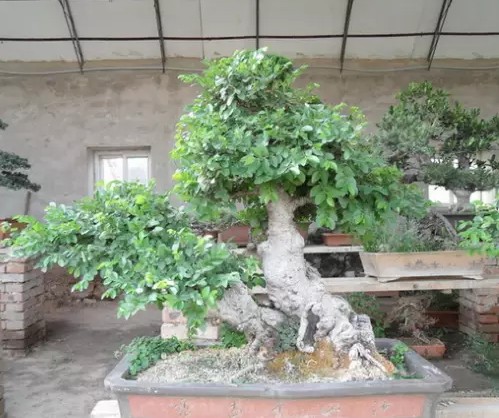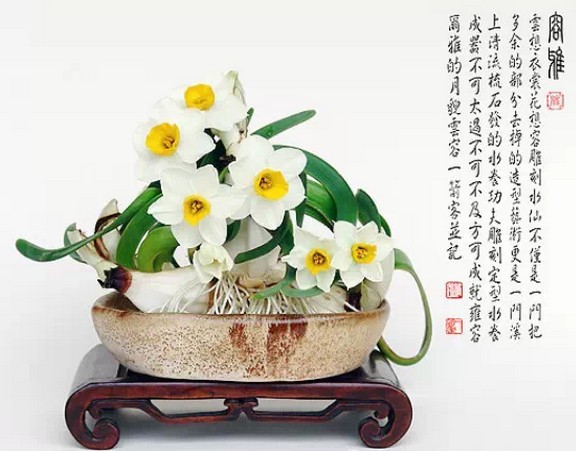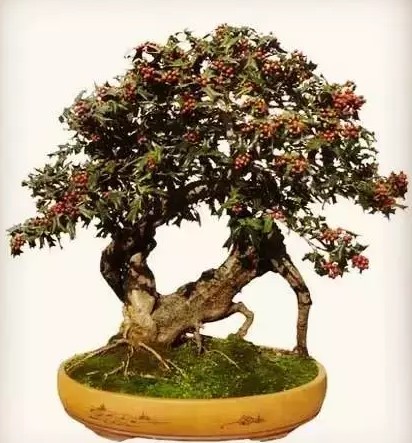Cultivation method of bonsai of Lycium chinense
Wolfbone wood is soft and tough and can be used as boxwood to make all kinds of utensils and carvings. Farmers use it as cattle nose tie, which should be a common and commonly used plant in the Yellow River Basin in the era of the Book of songs. Bark and leaves can be used medicinally and have the effect of nourishing yin and clearing heat. The seed medicine is called "Ten Gongyuzi", which is used to tonify the liver and kidney in traditional Chinese medicine. The leaves are leathery and smooth, resistant to pruning and brightly colored, and are often cultivated for ornamental use, so they are often used as green leaves and red fruits on western decorative Christmas trees.

Artificial reproduction:
Mainly sowing and propagation, cutting and tillering propagation can also be carried out. The fruit was ripe in November, piled up after harvest, pounded after the peel was softened, rinsed and taken out. The seeds of Chinese wolfberry should be germinated for 2 years and can be treated with low temperature and wet sand for one year and mixed every two months during sand storage to maintain a certain humidity and prevent the seeds from deteriorating. The seeds were sown in winter, with a row spacing of 15 cm, a depth of 2 cm, covered with scorched mud of 1.5 cm, and then covered with straw. It can be unearthed in March, uncover the grass in time and build a shed for shade. Usually pay attention to watering, topdressing, weeding and loosening soil and other management work, the growth of seedlings is slow, stay in bed for 1-2 years and then split.
Cutting propagation:
In the middle and last ten days of June (Meiyu season), the semi-mature branches of the same year were selected as cuttings with the length of heel (with some old branches of last year), leaving 4-6 leaves, deep 1B2~2B3, watering thoroughly after insertion, shading, watering frequently at ordinary times, and keeping the soil moist. After rooting, strengthen the management of seedling stage, stay in bed for 1-2 years and then transplant, the survival rate of spring migration is higher. Some of the roots can be dug up and propagated by tillers.
Notes for potted plants of Chinese wolfberry:
Habits: Chinese wolfberry is a small evergreen tree or shrub of holly family. It likes warm, moist and sunny environment, but it is also shady and has a certain degree of cold resistance. Potted plants should use slightly acidic soil rich in humus, fertile and well drained, generally put on the pot before germination in February-March in spring, water thoroughly after planting, and slow down seedlings in semi-shade for 2-3 weeks. When it is hot in summer, it is necessary to strengthen ventilation and shade slightly to prevent exposure to the hot sun.
Environment: Chinese wolfbone is resistant to yin and should be placed in a damp environment to grow. Need to be maintained under the shade or forest shade in summer. People are needed to spend the winter in winter.
Watering: the exuberant period needs to be watered frequently, and it is generally necessary to keep the basin soil moist without stagnant water. In summer, it is necessary to spray water to the leaves to facilitate evaporation and cooling, and it is necessary to create a small environment with moist air to make the leaves green and bright.
Fertilization: generally apply thin cake fertilizer and water every two weeks in spring, topdressing once a month in autumn, not fertilizing in summer and once in winter. Generally apply thin alum fertilizer water every 2-3 weeks, pay attention to comprehensive nutrition in the fertilizer solution, so that the leaves are verdant and the fruits are numerous.
Time: 2019-06-13 Click:
- Prev

The method of cultivating soil daffodils and the method of engraving water culture of daffodils bonsai
Daffodils are not cold-resistant and can be covered in open land for the winter in North China. Like warm winter, cool summer; like moist and sunny enough, resistant to semi-shade; require moist loose and well drained fertile clayey loam, but also resistant to drought and barren. Divide the ball to breed. Plant bulbs in autumn. Like water and fertilizer, need sufficient water and fertilizer during the growing period
- Next

The shaping of bonsai with Chinese wolfberry
Chinese wolfberry, also known as cat thorn, wolfbone holly, holly belongs to small evergreen trees or shrubs. The bark is gray and slippery, with dense branchlets. Simple leaves alternate, elliptic moment round, leathery, with 5 hard spines, bright surface, dark green. Flowers yellowish green, born in axils of leaves. Drupe globose, bright red
Related
- Fuxing push coffee new agricultural production and marketing class: lack of small-scale processing plants
- Jujube rice field leisure farm deep ploughing Yilan for five years to create a space for organic food and play
- Nongyu Farm-A trial of organic papaya for brave women with advanced technology
- Four points for attention in the prevention and control of diseases and insect pests of edible fungi
- How to add nutrient solution to Edible Fungi
- Is there any good way to control edible fungus mites?
- Open Inoculation Technology of Edible Fungi
- Is there any clever way to use fertilizer for edible fungus in winter?
- What agents are used to kill the pathogens of edible fungi in the mushroom shed?
- Rapid drying of Edible Fungi

